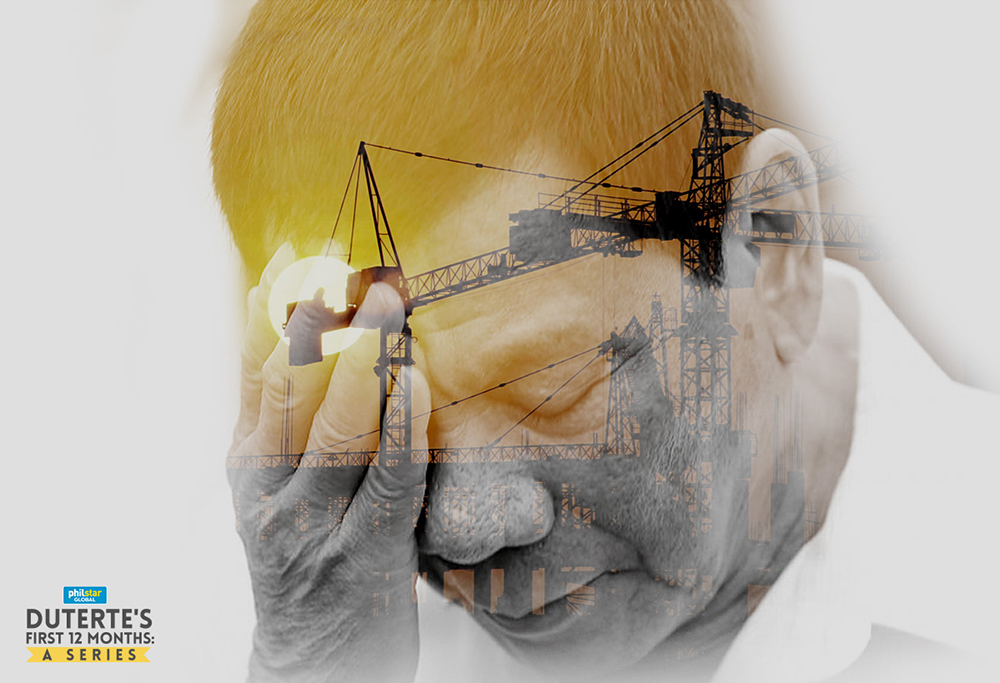A year of accelerated spending—or so they say

Philstar.com studied select data from the Department of Budget and Management that help demonstrate how fast—or slow—did the Duterte administration spend in its first year.
This piece is a part of a news analysis series on the first 12 months of the Duterte administration.
One of the promises of the Duterte administration was to speed up government spending, particularly in infrastructure. Budget Secretary Benjamin Diokno even went as far as saying that the government "would hit the ground running" by the time they took over last July.
A year later, however, government data showed that spending, while indeed growing, is not growing fast enough for it to be considered an acceleration.
The good news is agencies seemed to be on track for further growth. The bad news is the one-year-old government may have had been hit by absorptive capacity problems, which, if left unaddressed, could slow spending later on.
Philstar.com studied select data from the Department of Budget and Management that help demonstrate how fast—or slow—did the Duterte administration spend in its first year.
Figures included every step of the budget process beginning from allocation of funds, obligating them and then actual disbursement. While only the latter corresponds to actual spending, the rest of the steps are important to examine to see possible trend of expenditures going forward.
Agency spending
The government reports every month its spending performance. As of May, the latest data, spending by agencies grew 7 percent to P927.8 billion, making it faster than the 6.4-percent growth of the economy.
Despite this, three of the past 11 months in office showed that government spending actually contracted. These were in October 2016, down 7 percent, and February and April this year (down 1 and 4 percent).
At the start of his term, Diokno promised an "expansionary fiscal policy," one where the government will spend more to boost economic activity.
Earlier, he explained that the drop in spending in recent months in 2017 was a result of high base effects last year, when the previous government accelerated expenditures to complete projects before the elections.
An election ban on public spending takes effect during the campaign and poll period.
Allocation
Before actual spending can commence, funds will first need to be allocated or released to agencies. Release does not mean disbursement. It just gives agencies the capacity to enter into contracts with the private sector who will do the projects.
Data show that as of May, only 85.5 percent of the P3.5-trillion national budget had been released to agencies. This was the lowest allocation rate since the 84.8 percent recorded in 2011.
In 2011, the Aquino administration slowed disbursement supposedly in order to plug leaks in spending, which officials then said, were considered "wasteful." This, however, took a while to be turned around, resulting in years of below-target spending that Duterte now wants reversed.
Obligation
The good news is that the public can expect faster spending in the latter part of the year. DBM figures showed that the obligation rate of allocated funds hit 25.5 percent as of the first quarter of 2017.
Obligating funds means money is already under contract and may be paid soon to contractors depending on schedule. Once paid, funds will be deemed spent.
A higher 28.5 percent was recorded for capital outlays of funds meant specifically for infrastructure, figures showed.
Duterte promised to spend up to P8 trillion in infrastructure during his term in what was dubbed as what will be the "golden age of infrastructure." The goal is to spread economic development, especially to the countryside.
DPWH
The bad news is this may come a little too late for the rainy season when building infrastructure tends to be slower and may cause more public inconvenience.
As of May, three-quarters of the budget of the Department of Public Works and Highways had been released to the agency, allowing it to enter into contracts.
While this may sound big, the rate actually was the lowest among state agencies, most of which already have between 80 and 100 percent of their budget in their hands.
Again, having more funds at hand allows agencies to enter into contracts for future projects. Low allocation rate may signal that the DPWH is yet to satisfy some DBM requirements for the release of funds.
Infrastructure spending growth
Slowdown in DPWH allocation has translated to slower over-all infrastructure spending growth. For the first four months of the year, capital outlays rose 2.6 percent to P151 billion.
This was down from 60.3-percent growth recorded same period in 2016, an election year. However, it was a reversal of 1.9-percent dip in end-April 2015.
Going forward
Socioeconomic Planning Secretary Ernesto Pernia earlier said that public spending is expected to have an adjustment period. The challenge will be to ensure that this does not drag for months.
Diokno, for his part, realizes that underspending remains a challenge and vows to introduce reforms in procurement processes as well as pass a budget reform bill.
Details of the reforms have not been released. For now, agencies should be prodded to spend faster, while making sure every centavo is accounted for.
ALSO READ:
A year of Duterte's dystopian vision
A year of battling through traffic and train queues
A year of hits, misses and postponed promises
A year of consistent inconsistencies
— Graphics by RP Ocampo
- Latest
- Trending

























